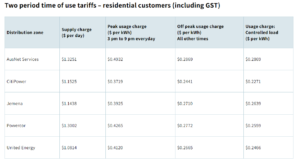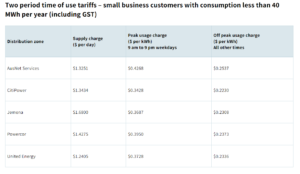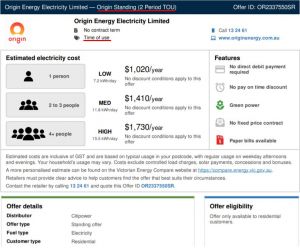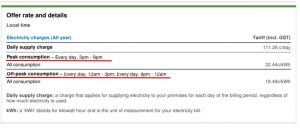By now, it’s safe to say that most Victorians would have spotted energy providers advertising how their prices stack up against the default tariff, known as the VDO or Victorian Default Offer. For those unaware, the VDO came into effect in July 2019 as a way for consumers to better compare energy deals from a ‘fairer’ reference price. But some may argue that this has just made finding a deal even more complicated.
Although the VDO set a maximum price that retailers could charge customers who didn’t actively engage in the market, it only applied to households connected to a single rate tariff. As of September 1, 2021 however, customers on flexible pricing tariffs, equipped with a smart meter were introduced to what’s called a two-period time of use VDO (a mouthful, we know!) to help them compare electricity plans against.
But, just what is the two-period time of use default tariff? In this piece, Canstar Blue will take you through what this VDO is, how it works, and ultimately what it means for you.
On this page:
- What is the two-period time of use VDO?
- How does the two-period time of use VDO work?
- Two-period time of use VDO residential pricing
- Two-period time of use VDO small business pricing
- How can customers sign up to this offer?
- How do I know if I’m on this tariff?
- Can I switch to the two-period time of use VDO?
- How to find a good energy deal in Victoria
What is the two-period time of use VDO?
Much like the Victorian Default Offer, the two-period time of use VDO acts as a safety net for Victorian energy customers on a time of use tariff. The two-period default tariff provides customers with a reference price for their peak and off-peak electricity rates. These default rates are claimed to better reflect the costs of using the network for customers on flexible pricing tariffs, at least according to Victoria’s energy regulator.
How does the two-period time of use VDO work?
Unlike traditional time of use tariffs which offer three time periods for customers (peak, off-peak and shoulder), this default time of use tariff offers, as the name suggests, only two time periods: peak and off-peak. Different pricing will be available during the different times of the day, allowing customers the opportunity to save money by using their energy efficiently. Peak times will be more expensive than off-peak times as these time periods are usually when power is in most demand.
As of July 1, 2023, the peak times on the two-period time of use VDO are:
- Residential: 3pm to 9pm every day
- Small business: 9am to 9pm every day
Off-peak periods will be at all other times of the day for both types of customers.
The way the default pricing works for this tariff is through a capped usage and supply charge amount. The daily supply charge for residential customers will be capped between $1.08 per kilowatt hour (kWh) and $1.32/kWh, depending on location. The usage rates, however, will fluctuate based on the time period. Residential customers can anticipate a peak capped price of 37c/kWh-49c/kWh and an off-peak cap of around 24c/kWh-28c/kWh, depending on location.
It should be noted that while these rates are the capped price, they likely won’t be the only price available for this kind of tariff. These rates simply act as reference point for providers on what the maximum is they can charge customers. Some providers may choose to offer a price below these rates – usually on deals that are referred to as ‘market offers.’
Two-period time of use VDO for residential customers

Image source: Essential Services Commission (ESC) website. Information accurate as of July 2023.
Two-period time of use VDO for small business customers

Image source: Essential Services Commission (ESC) website. Information accurate as of July 2023.
How can customers sign up to this offer?
Any customer who signs up to a new time of use tariff in Victoria, will be offered this pricing. Existing time of use customers who aren’t already on this tariff may be moved across at the end of their existing plan’s contract term. If the bill-payer no longer wishes to be on a time of use tariff at the end of their contract term, they are not required to stay on the this default tariff and will have the option of switching to a flat or demand load rate instead.
This default tariff is available to all Victorians whether they are currently on a time of use tariff or not. However, customers may need to ask their provider to switch them to this type of tariff in order to receive this pricing.
Can this tariff make energy prices cheaper for Victorians?
The Essential Services Commission (ESC) predicts that customers on this tariff will either earn the same level of savings as those on a flat rate tariff, or even be slightly better off. However, it’s important to remember with a time of use tariff, the amount of savings to be had is largely dependent on energy usage. If you are using more energy during peak demand periods than chances are your bill will be a lot higher. But, if you can monitor and track your power usage to avoid the peak costs, there could be some serious dollars in your back pocket.
How do I know if I am on this tariff?
If you live in Victoria and you have signed up to a new standing offer time of use tariff after September 1, 2021, chances are you are already on this default tariff. But if you are unsure, the best way to determine what type of tariff you’re on will be by looking at your energy price fact sheet from your provider.
At the top of the sheet, providers will list the type of tariff you are on. In regards to this default tariff, this maybe be phrased as ‘time of use default offer’, ‘2 Period TOU’ or even just ‘TOU’. Here is an example of what Origin Energy’s fact sheet for its two-period time of use VDO looks like.

Image source: Origin Energy website.
If you are having trouble finding this however, you can also take a look at the rates section of your sheet. Time of use tariffs break up rates into peak and off-peak periods, as seen in the example from Origin Energy below.

Image source: Origin Energy website.
It’s important to note that any changes made to your current plan, like a switch to this new default tariff, should be listed in the fine print somewhere on a previous bill. So, if you‘re unsure about what type of contract you’re on, it’s best to take a look at your latest bill, which should also list your contract type.
Not on a time of use tariff? Compare cheap single rate electricity plans in Victoria
Below we have listed some of the cheapest single rate electricity plans available on each distribution network in Victoria. Click on the tabs to see prices in your area.
Here are some of the cheapest published deals from the retailers on our database that include a link to the retailer’s website for further details. These are products from referral partners†. These costs are based on the Citipower network in Melbourne but prices may vary depending on your circumstances. This comparison assumes general energy usage of 4,000kWh/year for a residential customer on a single rate tariff. Please use our comparison tool for a specific comparison in your area. Our database may not cover all deals in your area. As always, check all details of any plan directly with the retailer before making a purchase decision.
Here are some of the cheapest published deals from the retailers on our database that include a link to the retailer’s website for further details. These are products from referral partners†. These costs are based on the Jemena network in Sunbury but prices may vary depending on your circumstances. This comparison assumes general energy usage of 4,000kWh/year for a residential customer on a single rate tariff. Please use our comparison tool for a specific comparison in your area. Our database may not cover all deals in your area. As always, check all details of any plan directly with the retailer before making a purchase decision.
Here are some of the cheapest published deals from the retailers on our database that include a link to the retailer’s website for further details. These are products from referral partners†. These costs are based on the United Energy network in Frankston but prices may vary depending on your circumstances. This comparison assumes general energy usage of 4,000kWh/year for a residential customer on a single rate tariff. Please use our comparison tool for a specific comparison in your area. Our database may not cover all deals in your area. As always, check all details of any plan directly with the retailer before making a purchase decision.
Here are some of the cheapest published deals from the retailers on our database that include a link to the retailer’s website for further details. These are products from referral partners†. These costs are based on the Powercor network in Bareena but prices may vary depending on your circumstances. This comparison assumes general energy usage of 4,000kWh/year for a residential customer on a single rate tariff. Please use our comparison tool for a specific comparison in your area. Our database may not cover all deals in your area. As always, check all details of any plan directly with the retailer before making a purchase decision.
Here are some of the cheapest published deals from the retailers on our database that include a link to the retailer’s website for further details. These are products from referral partners†. These costs are based on the AusNet network in Warragul but prices may vary depending on your circumstances. This comparison assumes general energy usage of 4,000kWh/year for a residential customer on a single rate tariff. Please use our comparison tool for a specific comparison in your area. Our database may not cover all deals in your area. As always, check all details of any plan directly with the retailer before making a purchase decision.
Can I switch to the two-period time of use VDO?
Yes, any Victorian is welcome to switch to this tariff, regardless of whether they were previously a time of use customer or not. But if you are on a single rate tariff, you will need to contact your provider in order to switch to this tariff. Keep in mind however, that customers will also need a smart meter installed at their property in order to allow for time of use pricing.
How to find a good energy deal in Victoria
With more benchmark prices for consumers to compare deals from in Victoria, energy competition in the state is well and truly heating up. Not only are more retailers slashing prices off the default offer, but many are starting to offer more value-add incentives too, like customer rewards programs, bill credits and even movie tickets. With our free comparison tool, you can compare a range of features on energy plans from some of Victoria’s biggest energy providers. And best of all, it’s absolutely free! Put the power back in your hands and visit the link below.

Image credit: WITSALUN/Shutterstock.com, Origin Energy, Essential Services Commission Victoria



Share this article